Germany
 I love watching the pigeons that fly around at one end of the walking path I use regularly. They are wild of course, but maybe at one time they were owned…or maybe their parents were. Now, they are free to soar around in beautiful formations, as they enjoy the freedom of being carefree and, well just being birds. Not all pigeons are free, however, and some even perform a very important service…some to their country. Pigeons have actually been used in wars to carry messages to different battalions, sadly because they were expendable, where the men were not.
I love watching the pigeons that fly around at one end of the walking path I use regularly. They are wild of course, but maybe at one time they were owned…or maybe their parents were. Now, they are free to soar around in beautiful formations, as they enjoy the freedom of being carefree and, well just being birds. Not all pigeons are free, however, and some even perform a very important service…some to their country. Pigeons have actually been used in wars to carry messages to different battalions, sadly because they were expendable, where the men were not.
One famous pigeon known as “President Wilson,” was hatched in France. “President Wilson” (this special pigeon) assisted both the American tank corps and US infantry men in their fight against Germany. It was in the Meuse-Argonne Offensive, that “President Wilson” made his most famous flight. He was assisting the 78th Infantry near Grandpre. The battle had been a vicious one, and while engaging the enemy on the morning of October 5, 1918, President Wilson’s unit released him to request artillery support. No flight through a battleground was easy, but this one was especially dangerous. A bird can’t really fly without being seen, and the Germans knew to watch for pigeons. The German soldiers opened fire on him, peppering him with bullets. “President Wilson” sustained numerous injuries, nevertheless, he was able to make his flight back to headquarters in record setting time…under 25 minutes. “President Wilson” survived his wounds, after which he was retired and sent to the US Army Signal Corps Breeding and Training Center at Fort Monmouth, New Jersey, where he would live another eleven years. After his death, Wilson was taxidermized and presented to the Smithsonian Institution. He was transferred to the custody of the US Army in 2008. “President Wilson” is now located in the prestigious halls of the US military’s headquarters in Arlington, Virginia. He serves as a reminder that these simple birds…often considered a nuisance by the general public…were once war heroes.
Another famous pigeon was known as Cher Ami, who also gained fame during World War I. Cher Ami’s moment of heroism came during the actions of the so-called “Lost Battalion.” With the 77th Division finding themselves  surrounded by the German army, besieging them for five days, Cher Ami was the third pigeon sent out to tell division headquarters that the men were surrounded and were taking fire, both enemy and friendly!! Cher Ami was hit almost as quickly as he rose. He was shot down but managed to take flight again. He arrived back at his loft at division headquarters 25 miles to the rear in just 25 minutes, helping to save the lives of the 194 survivors. He had been shot through the breast, blinded in one eye, and had a leg hanging only by a tendon. Cher Ami was the last pigeon available. Had he not made it, the men would have been on their own. Cher Ami was stuffed and mounted after his death and is now in the Smithsonian Museum of American History.
surrounded by the German army, besieging them for five days, Cher Ami was the third pigeon sent out to tell division headquarters that the men were surrounded and were taking fire, both enemy and friendly!! Cher Ami was hit almost as quickly as he rose. He was shot down but managed to take flight again. He arrived back at his loft at division headquarters 25 miles to the rear in just 25 minutes, helping to save the lives of the 194 survivors. He had been shot through the breast, blinded in one eye, and had a leg hanging only by a tendon. Cher Ami was the last pigeon available. Had he not made it, the men would have been on their own. Cher Ami was stuffed and mounted after his death and is now in the Smithsonian Museum of American History.
Looking back on World War I, and the many lives lost, we also need to remember that without war heroes like “President Wilson” and Cher Ami the losses would have been far greater. Many pigeons lost their lives in these efforts, but they were heroes for the sacrifices they made. I’m sure the soldiers knew that well.
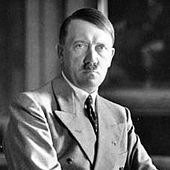
 There are certain situations when I think citizenship is a must have element, and some that I think “natural-born” citizenship is absolutely essential. On September 15, 1935, German Jews were stripped of their citizenship, reducing them to mere “subjects” of the state. This heinous crime was carried out by the “president and chancellor of Germany,” Adolf Hitler. I use the quotation marks, because Hitler should never have been allowed to be in that office. Adolf Hitler became a citizen of Germany on February 25, 1932. Hitler, who was born in Austria, had immigrated to Germany in 1913, and renounced his Austrian citizenship in 1925. Hitler was a stateless nomad from 1925 to 1931, when he decided on the political ambition of becoming president and chancellor. That was when he decided to become a citizen, in fact that was the only reason he became a citizen. Hitler had a plan to take over and completely transform Germany, and his “transformation” was to be the worst thing for Germany. I think that is why a president needs to be a “natural-born” citizen. A president needs to have a connection to his country…a connection he is born into. Then and only then does he have the ability to care about the country…not that all presidents do, but they have that ability, because they belong. I’m sure some would disagree with me, but it will not change my mind.
There are certain situations when I think citizenship is a must have element, and some that I think “natural-born” citizenship is absolutely essential. On September 15, 1935, German Jews were stripped of their citizenship, reducing them to mere “subjects” of the state. This heinous crime was carried out by the “president and chancellor of Germany,” Adolf Hitler. I use the quotation marks, because Hitler should never have been allowed to be in that office. Adolf Hitler became a citizen of Germany on February 25, 1932. Hitler, who was born in Austria, had immigrated to Germany in 1913, and renounced his Austrian citizenship in 1925. Hitler was a stateless nomad from 1925 to 1931, when he decided on the political ambition of becoming president and chancellor. That was when he decided to become a citizen, in fact that was the only reason he became a citizen. Hitler had a plan to take over and completely transform Germany, and his “transformation” was to be the worst thing for Germany. I think that is why a president needs to be a “natural-born” citizen. A president needs to have a connection to his country…a connection he is born into. Then and only then does he have the ability to care about the country…not that all presidents do, but they have that ability, because they belong. I’m sure some would disagree with me, but it will not change my mind.
His citizenship actually came about when a fellow member of the Nazi Party appointed Hitler to a low-level government job that came with automatic citizenship. Once he was a citizen, Hitler’s new status allowed him to achieve his political goals. As a citizen, he could run for office. Hitler made sure that he was well liked, and by the middle of 1934, he was in complete control of Germany as Führer und Reichskanzler (leader and chancellor). He didn’t wait long to begin, and soon redefined citizenship to serve his beliefs. He was a hate-filled man, and he used race and pan-German heritage to give citizenship to, and take it from, large groups of people. Citizenship now depended on how Hitler felt about the people. Many would say that he was a white supremacist, but the reality was that there were many races of people he didn’t like, and many of them were white, so it wasn’t about color. As World War II began, Hitler’s views on German supremacy were fueling a military campaign that destroyed borders and entire populations all across Europe. People who were born in Germany and had been citizens all their lives were being systematically stripped of their citizenship, their rights, and their lives, just because they were Jews, blacks, gypsies, and some other races. Hitler’s goal was to rid the world of anyone who was not “pure-blooded” German stock. Never mind the fact that he was not!!
Practically from the minute he took office, Hitler began issuing what we would call “Executive Orders” that barely disrupted the lives of those “pure-blooded” German stock, other than to basically elevate them to the level of “masters” over anyone who did not qualify as “pure-blooded” German stock. His dream of a “pure-blooded” society soon became a nightmare for many. Many of the German “pure-blooded” German citizen didn’t agree with what he was doing, and some didn’t really understand what he was doing, exactly, but some of them saw it as an opportunity to take from the “unqualified” citizens, anything they wanted. They became brutal in their treatment of the “unqualified” citizens, especially the Jews.
Hitler began his persecution of the Jews within the first year of office. German Jews were excluded from many high-profile vocations, such as public office, journalism, radio, theater, film, and teaching, and even farming. The professions of law and medicine were also withdrawn slowly as opportunities. “Jews Not Welcome” signs were posted on shop and hotel windows, beer gardens, and other public areas. Known as the Nuremberg Laws, these discriminatory acts became a deep-seated part of the German culture, which in turn, making them even more far-reaching. Jews were forbidden to marry “Aryans” or engage in extramarital relations with them. Jews could not employ female Aryan servants if they were less than 35 years of age. Hunger soon became a part of Jewish life, because it became difficult even to buy food, as groceries, bakeries, and dairies would not admit Jewish customers. Even pharmacies refused to sell them medicines or drugs. Their lives soon began to simply spiral towards despair and eventual death.
At first, the outside world didn’t understand what they were seeing. Unemployment had dropped exponentially under Hitler’s early commandeering of the economy. Things actually looked better to the world. A very few, some foreign visitors, even some political opponents within Germany itself, saw these racist laws and practices for what they were, but most were beguiled into thinking it was merely a phase. They assumed that the “birth 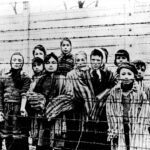
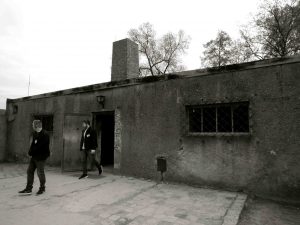 pains” of Hitler’s developing plans would eventually smooth out and the bad parts would fade away, as he began to focus more on the economy and less on race, but they were wrong, because Hitler was a very determined, and very focused dictator…and he was insane, as the world and the German people would soon find out. It is my opinion that even a seemingly good citizen, who is not “natural-born” is not a good candidate for president, because their ideas and plans for a nation they have no real stake in, will be very unlikely to produce good for the nation in the end.
pains” of Hitler’s developing plans would eventually smooth out and the bad parts would fade away, as he began to focus more on the economy and less on race, but they were wrong, because Hitler was a very determined, and very focused dictator…and he was insane, as the world and the German people would soon find out. It is my opinion that even a seemingly good citizen, who is not “natural-born” is not a good candidate for president, because their ideas and plans for a nation they have no real stake in, will be very unlikely to produce good for the nation in the end.
 As we all know, Adolph Hitler was a liar and a murderer. He really never made a move that wasn’t calculated and devious. On September 1, 1939, German forces under the control of Adolf Hitler bombarded Poland on land and from the air. The invasion was more than just a taking of territory. Hitler knew that he might need that area later, and so he did. Hitler had been murdering people that didn’t fit into his mold of “life that had value” and that included Jews, the mentally or physically handicapped, and later gypsies and other ethnicities. Basically, he wanted to eliminate anyone that wasn’t Aryan. Aryan is a word relating to a hypothetical ethnic type illustrated by or descended from early speakers of Indo-European languages. To Hitler it meant white, with blond hair and blue eyes. Oddly, while Hitler had blue eyes, his hair was brown. Somehow that “problem” with his definition of Aryan didn’t concern Hitler. I guess he was happy to be a “special Aryan.” In reality, there are different kinds of Aryans. They can be found with blond, red, brown, white, or black hair, so that wasn’t really an issue either. Hitler considered himself Aryan because he was a native German-speaker, and he knew the definition of “Aryan” as it was used in those days. I don’t think it was ever about Aryan, per se, but rather about getting rid of any group that he decided that he didn’t like.
As we all know, Adolph Hitler was a liar and a murderer. He really never made a move that wasn’t calculated and devious. On September 1, 1939, German forces under the control of Adolf Hitler bombarded Poland on land and from the air. The invasion was more than just a taking of territory. Hitler knew that he might need that area later, and so he did. Hitler had been murdering people that didn’t fit into his mold of “life that had value” and that included Jews, the mentally or physically handicapped, and later gypsies and other ethnicities. Basically, he wanted to eliminate anyone that wasn’t Aryan. Aryan is a word relating to a hypothetical ethnic type illustrated by or descended from early speakers of Indo-European languages. To Hitler it meant white, with blond hair and blue eyes. Oddly, while Hitler had blue eyes, his hair was brown. Somehow that “problem” with his definition of Aryan didn’t concern Hitler. I guess he was happy to be a “special Aryan.” In reality, there are different kinds of Aryans. They can be found with blond, red, brown, white, or black hair, so that wasn’t really an issue either. Hitler considered himself Aryan because he was a native German-speaker, and he knew the definition of “Aryan” as it was used in those days. I don’t think it was ever about Aryan, per se, but rather about getting rid of any group that he decided that he didn’t like.
Hitler’s main purpose for the invasion of Poland was to regain lost territory and ultimately rule their eastern neighbor. Mostly, however, Hitler wanted the world to know exactly how he planned to wage war. This would become the “blitzkrieg” strategy. The Blitzkrieg was a term used to describe “a method of offensive warfare designed to strike a swift, focused blow at an enemy using mobile, maneuverable forces, including armored 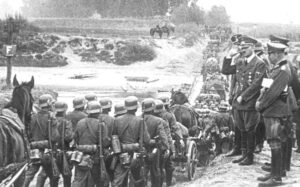 tanks and air support. Such an attack ideally leads to a quick victory, limiting the loss of soldiers and artillery. After the German forces had plowed their way through, devastating a swath of territory, infantry moved in, picking off any remaining resistance.”
tanks and air support. Such an attack ideally leads to a quick victory, limiting the loss of soldiers and artillery. After the German forces had plowed their way through, devastating a swath of territory, infantry moved in, picking off any remaining resistance.”
Hitler was methodical. He established a base of operations within the target country. Then, he immediately began setting up “security” forces to take out anyone who disagreed with his Nazi ideology, whether racial, religious, or political. He set up concentration camps for slave laborers and the extermination of uncooperative civilians. It didn’t take long for the target nation, in this case Poland to become a conquered nation under German rule. Just one day after the German invasion of Poland, Hitler was busy setting up SS “Death’s Head” regiments to terrorize the people. He was preparing for his planned terror.
The Polish army tried to fight back, but they made several severe strategic miscalculations in those early days. Even with an army of 1 million soldiers, the lack of the necessary equipment was a severe detriment to the Polish forces as they attempted to take the Germans head-on, when maybe they should have fallen back to defensive positions. I think the natural way to face an enemy, is head-on. We try to “show no fear” when attacked, but in the end, this thinking, while admirable was probably behind the times, at least in battle, and the brave Polish soldiers were no match for the overwhelming and modern-mechanized German forces. To make matters worse, any hope the Polish soldiers might have had of a Soviet counter-response was lost with 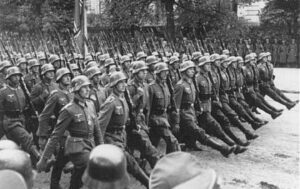 the signing of the Ribbentrop-Molotov Nonaggression Pact…”a non-aggression pact between Nazi Germany and the Soviet Union that partitioned Eastern Europe between them. The pact was signed in Moscow on 23 August 1939 by German Foreign Minister Joachim von Ribbentrop and Soviet Foreign Minister Vyacheslav Molotov and was officially known as the Treaty of Non-Aggression between Germany and the Union of Soviet Socialist Republics. Unofficially, it has also been referred to as the Hitler–Stalin Pact, Nazi–Soviet Pact or Nazi–Soviet Alliance.” Germany invaded Poland on September 1, 1939. Great Britain responded with bombing raids over Germany three days later.
the signing of the Ribbentrop-Molotov Nonaggression Pact…”a non-aggression pact between Nazi Germany and the Soviet Union that partitioned Eastern Europe between them. The pact was signed in Moscow on 23 August 1939 by German Foreign Minister Joachim von Ribbentrop and Soviet Foreign Minister Vyacheslav Molotov and was officially known as the Treaty of Non-Aggression between Germany and the Union of Soviet Socialist Republics. Unofficially, it has also been referred to as the Hitler–Stalin Pact, Nazi–Soviet Pact or Nazi–Soviet Alliance.” Germany invaded Poland on September 1, 1939. Great Britain responded with bombing raids over Germany three days later.
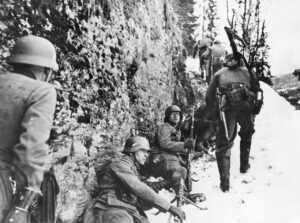 During the largely unsuccessful Norwegian Campaign of World War II, the Allies were in a fight to stop the Germans from fully occupying Norway, but it didn’t work in the end. The Norwegian campaign was carried out from April 8, 1940 to June 10, 1940, and involved the attempt by Allied forces to defend northern Norway coupled with the resistance of the Norwegian military to the country’s invasion by Nazi Germany.
During the largely unsuccessful Norwegian Campaign of World War II, the Allies were in a fight to stop the Germans from fully occupying Norway, but it didn’t work in the end. The Norwegian campaign was carried out from April 8, 1940 to June 10, 1940, and involved the attempt by Allied forces to defend northern Norway coupled with the resistance of the Norwegian military to the country’s invasion by Nazi Germany.
The Norwegian Campaign was planned as Operation Wilfred and Plan R 4, prior to the actual German attack, which the Allies knew was imminent, but had not yet happened. On April 4th, the battlecruiser HMS Renown set out from Scapa Flow for the Vestfjorden with twelve destroyers. The Royal Navy and the  Kriegsmarine met at the First Battle of Narvik on April 9 – 10. The British forces conducted the Åndalsnes landings on April 13, thereby putting everything in place for the actual operation. Germany’s strategic reason for wanting Norway was to seize the port of Narvik and guarantee the delivery of iron ore needed for German steel production. In any war, steel is necessary for much of the weaponry.
Kriegsmarine met at the First Battle of Narvik on April 9 – 10. The British forces conducted the Åndalsnes landings on April 13, thereby putting everything in place for the actual operation. Germany’s strategic reason for wanting Norway was to seize the port of Narvik and guarantee the delivery of iron ore needed for German steel production. In any war, steel is necessary for much of the weaponry.
During one part of that campaign, in an air fight over Norway, a British fighter took down a German plane over a densely wooded area. Unfortunately, the British aircraft crashed as well. As it turns out, both crews survived the crashes, and while trying to get to a safe place, they encountered each other in the wilderness. In most situations, this could have been bad for one or both of the crews, but even though they were struggling against a language barrier, the rival airmen agreed not to turn on each other and instead, to team up in order to find 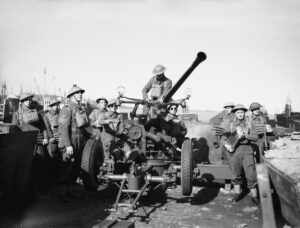 safety. They stayed in an abandoned hotel and shared breakfast. It wasn’t peace exactly, but they formed an uneasy truce, while they waited to see which side would show up to help first.
safety. They stayed in an abandoned hotel and shared breakfast. It wasn’t peace exactly, but they formed an uneasy truce, while they waited to see which side would show up to help first.
Instead of the British or the Germans, it was a Norwegian ski patrol that showed up to rescue the British soldiers, and of course, to take the Germans as POWs. While that one battle seemed to indicate that the British were headed for a victory over the Germans, that was not to be the case. The Germans did finally take over Norway in its entirety. Of course, as we all know, one battle is not a very good indication of who will win the war, and in the end, it was Germany that took a great fall, losing the entirety of World War II.

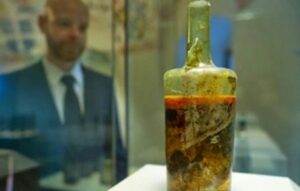 Most people know that wine gets better with age, but I wonder if there is a limit to that statement. Some wines, I’m told wine can be aged for 10 to 20 years, but there really is a limit. In a Roman tomb in Germany in 1867, a bottle of wine was found that is believed to date back to 325 – 350 CE. The oldest bottle of wine ever found. Those who found it, named it Speyer, for the city of Speyer, near where the bottle was found. The bottle was discovered during an excavation of a 4th-century AD Roman nobleman’s tomb. The tomb contained two sarcophagi, one holding the body of a man and one a woman. It was a very unique bottle, with dolphin-shaped handles, and it is sealed with wax and olive oil. I’m sure that was the hope that by so preserving the wine, that it would be able to be used later, but then it was found in a tomb, so I’m not sure of the actual purpose. There were several other bottles found with the Speyer bottle, but they were all empty or broken.
Most people know that wine gets better with age, but I wonder if there is a limit to that statement. Some wines, I’m told wine can be aged for 10 to 20 years, but there really is a limit. In a Roman tomb in Germany in 1867, a bottle of wine was found that is believed to date back to 325 – 350 CE. The oldest bottle of wine ever found. Those who found it, named it Speyer, for the city of Speyer, near where the bottle was found. The bottle was discovered during an excavation of a 4th-century AD Roman nobleman’s tomb. The tomb contained two sarcophagi, one holding the body of a man and one a woman. It was a very unique bottle, with dolphin-shaped handles, and it is sealed with wax and olive oil. I’m sure that was the hope that by so preserving the wine, that it would be able to be used later, but then it was found in a tomb, so I’m not sure of the actual purpose. There were several other bottles found with the Speyer bottle, but they were all empty or broken.
Of course, given the age of the bottles, no one will ever drink the contents. It would not be safe, so the exact contents remain unknown. Nevertheless, archaeologists believe the liquid inside was made from grapes planted in the region. The Speyer wine bottle (Römerwein in German) is a sealed bottle that is will not been opened to check the contents. Even without verification, it is considered the world’s oldest known bottle of wine. Since the discovery of the bottle, it has been exhibited at the Wine Museum section of the Historical Museum of the Palatinate in Speyer. The “Römerwein” is housed in the museum’s Tower Room. It is a 51 US fluid ounce glass bottle with amphora-like “shoulders” that are yellow green in color and with dolphin-shaped handles.
It is thought that the man in the tomb was a Roman legionary, and the wine was a provision for his journey to  Heaven. People had some strange customs back then, and some may still have. Of the six glass bottles in the woman’s sarcophagus and the ten vessels in the man’s sarcophagus, only one still contained a liquid. There is a clear liquid in the bottom third, and a mixture similar to rosin above. While it has reportedly lost its ethanol content, analysis is consistent with at least part of the liquid having been wine, although I’m not sure how they made that analysis without opening the bottle. The wine was infused with a mixture of herbs, but the preservation of the wine is attributed to the large amount of thick olive oil. Since I’m not a scientist, I’m not sure how that would work, but apparently it did, as it was added to the bottle to seal the wine off from air, along with a hot wax seal. The use of glass in the bottle is unusual, however, as typically Roman glass was too fragile to be dependable over time.
Heaven. People had some strange customs back then, and some may still have. Of the six glass bottles in the woman’s sarcophagus and the ten vessels in the man’s sarcophagus, only one still contained a liquid. There is a clear liquid in the bottom third, and a mixture similar to rosin above. While it has reportedly lost its ethanol content, analysis is consistent with at least part of the liquid having been wine, although I’m not sure how they made that analysis without opening the bottle. The wine was infused with a mixture of herbs, but the preservation of the wine is attributed to the large amount of thick olive oil. Since I’m not a scientist, I’m not sure how that would work, but apparently it did, as it was added to the bottle to seal the wine off from air, along with a hot wax seal. The use of glass in the bottle is unusual, however, as typically Roman glass was too fragile to be dependable over time.
Scientists have considered opening the bottle to further analyze the contents, but as of 2023 the bottle has remained unopened, mostly because of concerns about how the liquid would react when exposed to air. The museum’s curator, Ludger Tekampe has stated he has seen no changes in the bottle in over 25 years, so whatever they are doing to preserve it is working. It seems to me that scientists would be remiss in their care of this bottle by opening it for no good reason. I think it should be left as is.
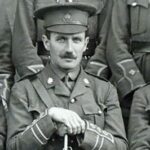
 World War I was a different era, even in the way war was conducted. Oh, war is still war, and there is wounding, bombing, killing, and capturing. Nevertheless, with one leader, Kaiser Wilhelm II, there was also compassion. After being captured and placed in a POW camp, a British officer, Captain Robert Campbell found out that his mother was dying. He couldn’t bear the thought of not seeing his mother before she passed away, and in his grief, he took a chance. He appealed to Kaiser Wilhelm II, asking to be allowed to go home to visit his mother before she died. Amazingly, Kaiser Wilhelm II granted his request, on the condition that he return to the POW camp after the visit.
World War I was a different era, even in the way war was conducted. Oh, war is still war, and there is wounding, bombing, killing, and capturing. Nevertheless, with one leader, Kaiser Wilhelm II, there was also compassion. After being captured and placed in a POW camp, a British officer, Captain Robert Campbell found out that his mother was dying. He couldn’t bear the thought of not seeing his mother before she passed away, and in his grief, he took a chance. He appealed to Kaiser Wilhelm II, asking to be allowed to go home to visit his mother before she died. Amazingly, Kaiser Wilhelm II granted his request, on the condition that he return to the POW camp after the visit.
When you think about it, once he was safely home with his mother, Captain Campbell could have simply stayed. Seriously, what could the Kaiser have done about it. Nevertheless, being an honorable man, Captain Campbell kept his promise to Kaiser Wilhelm II and returned from Kent to Germany after visiting his mother for a week. He stayed at the camp until the war ended in 1918. That was not the end of the story, however.

On August 24, 1914, then 29-year-old Captain Campbell, of the 1st Battalion East Surrey Regiment, was captured in northern France. He was sent to a prisoner-of-war (POW) camp in Magdeburg, north-east Germany. It was there that he received the heartbreaking news that his mother, Louise was dying of cancer. Captain Campbell traveled through the Netherlands and then by boat and train to Gravesend in Kent, where he spent a week with his mother before returning to Germany the same way. His mother died in February 1917.
With the kindness of the Kaiser, and a duty to honor his word, Captain Campbell, knowing that if he didn’t return, no one else would ever be given that same consideration, Captain Campbell returned to Germany. Strangely, there was no issues during his return. I suppose the Kaiser could have cleared the way previously, but it would be my guess that the Kaiser was just as shocked by the return as I am. Unfortunately, Britain wasn’t as considerate, because they blocked a similar request from German prisoner Peter Gastreich, who was being held at an internment camp on the Isle of Man. After that no other British prisoners of war were afforded compassionate leave.
As for Captain Campbell, while he felt duty-bound to return to captivity, he did not feel duty-bound to stay in 
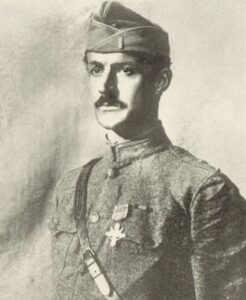 captivity. As soon as Captain Campbell returned to the camp, he set about trying to escape. He and a group of other prisoners spent nine months digging their way out of the camp before being captured on the Dutch border and sent back. He remained in the camp until 1918 and served in the military until 1925. Captain Campbell rejoined the military when World War II broke out in 1939 and served as the chief observer of the Royal Observer Corps on the Isle of Wight. He died in the Isle of Wight in July 1966, aged 81.
captivity. As soon as Captain Campbell returned to the camp, he set about trying to escape. He and a group of other prisoners spent nine months digging their way out of the camp before being captured on the Dutch border and sent back. He remained in the camp until 1918 and served in the military until 1925. Captain Campbell rejoined the military when World War II broke out in 1939 and served as the chief observer of the Royal Observer Corps on the Isle of Wight. He died in the Isle of Wight in July 1966, aged 81.
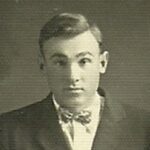
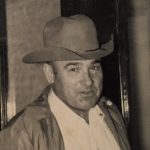 My husband’s grandfather, Andrew Carl Schulenberg was an interesting character. Born on March 12, 1906, to Max Heinrich Johann Carl Schulenberg and Julia Marie Doll. His dad was born in Oldenburg, Lower Saxony, Germany, and in those days, children were often given multiple middle names. I have always found that to be of interest, as I used to think that pretty much only royal children were given multiple middle names. It actually isn’t all that uncommon and many children today have multiple middle names. Max had immigrated to America by the time he met Julia, and they were married in Blair, Nebraska. Their oldest son, Andrew was born in Herman, Nebraska, as were his sisters Anna and Claudine. The rest of Andrew’s nine siblings were born in Forsyth, Montana.
My husband’s grandfather, Andrew Carl Schulenberg was an interesting character. Born on March 12, 1906, to Max Heinrich Johann Carl Schulenberg and Julia Marie Doll. His dad was born in Oldenburg, Lower Saxony, Germany, and in those days, children were often given multiple middle names. I have always found that to be of interest, as I used to think that pretty much only royal children were given multiple middle names. It actually isn’t all that uncommon and many children today have multiple middle names. Max had immigrated to America by the time he met Julia, and they were married in Blair, Nebraska. Their oldest son, Andrew was born in Herman, Nebraska, as were his sisters Anna and Claudine. The rest of Andrew’s nine siblings were born in Forsyth, Montana.
After a hunting accident took his right leg, Andy had a true peg leg for the rest of his life. Maybe it was the fact that he was only in his teens when it happened, or maybe it was just his own determined personality, but Andy did not let a “little thing” like an amputated leg turn him into an invalid. He went forward with his life…after about a year in the hospital, that is. And while he really didn’t like guns much after that, he was still capable of using one if needed. And actually, went on to become the sheriff of Rosebud County, Montana, and did it without a gun. I suppose it might have seemed a little bit like Sheriff Andy Taylor on the Andy Griffith Show, but I can’t say that Forsyth, or Rosebud County, was a tame as Mayberry was. Andy took it all in stride, worked with multiple agencies over his years as sheriff, and handled the Indian nation with mutual respect and grace. That was the reason they worked so well with him.
I first met Andy at a family reunion when my girls were about 6 and 5 years old. He was, of course their great 
 grandfather. And he seemed bigger than life. He was a tall…very tall man, but then I’m short, and maybe not a good judge of height. Still, I would guess 6 foot 3 inches, at last. His son, Uncle Butch Schulenberg could probably tell me for sure. Nevertheless, as big as he was, he took the time to build two small chairs for my girls, chairs they still love to this day. He was excited to meet them, and they were excited to meet him. I will always be glad we had that time with him. Today is the 117th anniversary of Grandpa Andy Schulenberg’s birth. Happy birthday in Heaven, Grandpa. We love and miss you very much.
grandfather. And he seemed bigger than life. He was a tall…very tall man, but then I’m short, and maybe not a good judge of height. Still, I would guess 6 foot 3 inches, at last. His son, Uncle Butch Schulenberg could probably tell me for sure. Nevertheless, as big as he was, he took the time to build two small chairs for my girls, chairs they still love to this day. He was excited to meet them, and they were excited to meet him. I will always be glad we had that time with him. Today is the 117th anniversary of Grandpa Andy Schulenberg’s birth. Happy birthday in Heaven, Grandpa. We love and miss you very much.
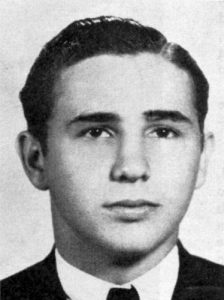
 Once upon a time, journalists and the media as a whole had an obligation to tell the truth, or at least tell the public that the story was their opinion only. The had to have reliable sources, even if they didn’t have to disclose them. While they weren’t “forced” to be truthful, they were completely shunned if they didn’t.
Once upon a time, journalists and the media as a whole had an obligation to tell the truth, or at least tell the public that the story was their opinion only. The had to have reliable sources, even if they didn’t have to disclose them. While they weren’t “forced” to be truthful, they were completely shunned if they didn’t.
When a journalist is mesmerized by someone, they can definitely fall hard for them. Such was the case with “the job-creating Führer with eyes that were like ‘blue larkspur.'” Why did so many journalists spend years dismissing the evidence of Hitler’s atrocities? Some, like the Christian Science Monitor called Hiter’s effect on Germany as providing “a dark land a clear light of hope.” They talked about how smoothly things were running, how well regulated everything was, and how great the police uniforms were. Strangely, when it came to the killing of the Jewish people, they said things like, “I have so far found quietness, order, and civility;” there was “not the slightest sign of anything unusual afoot.” As for all those “harrowing stories” of Jews being mistreated…they seemed to apply “only to a small proportion;” most were “not in any way molested.” They made it seem like as long as the number were “low,” the problem couldn’t possibly be a big one. Well, the reality as we all know now is that the “problem” was enormous, heinous, and horrific beyond imagination.
Trusting the journalists implicitly, without doing your own research is a very dangerous plan. Journalists have been known to assist in “hiding the evidence” in a matter…as we have seen in recent years. I don’t believe that all journalists are “bad” people, but those that are “bad” people ruin the reputation of journalism for every good journalist. I’m not even sure I would call some of the media, journalists. They are truly just “bad fiction writers,” in my opinion. Anyone who covers up the truth in the name of free speech or forces others to hide the truth in the name of tolerance is a bad journalist.
Many in the American mainstream newspaper industry portrayed the Hitler regime positively, especially in its 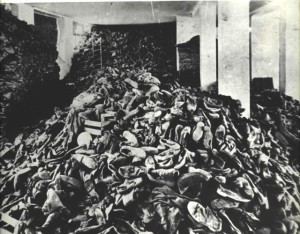
 early months. Looking back now, we wonder how they could have said the good things they said about such a horrible dictator. The media published warm human-interest stories about Hitler, while simply excusing or rationalizing Nazi anti-Semitism. These actions should haunt the conscience of United States Journalism to this day. There was no excuse for what Hitler did, and to write it off as “not so bad” was absolutely inexcusable.
early months. Looking back now, we wonder how they could have said the good things they said about such a horrible dictator. The media published warm human-interest stories about Hitler, while simply excusing or rationalizing Nazi anti-Semitism. These actions should haunt the conscience of United States Journalism to this day. There was no excuse for what Hitler did, and to write it off as “not so bad” was absolutely inexcusable.
Of course, not all of the “bad journalism” of the day was sinister. Hitler was an unfamiliar subject when he first appeared on the international scene. His ideals and his movement were unknown, and so could have been mistaken for something quite innocent…at first. The Nazis had risen from barely 18 percent of the national vote in mid-1930 to become Germany’s largest party only two years later and gained power just months after that. I suppose that the political rise of Hitler could have just seemed like someone with great ideas stepping up to the microphone. It is thought that many American editors and reporters erroneously assumed, based on previous experience, that a radical candidate would show some restraint once in office, but that was not Hitler’s plan. He planned to take over the world…to become a One World Government. Really, any time anyone tries to take away the sovereignty of a country, they are not acting in the best interest of that country. That is something we must never forget.
An editorial in the Philadelphia Evening Bulletin on January 30, 1933, asserted that “there have been indications of moderation” on Hitler’s part. The editors of The Cleveland Press, on January 31, 1933, claimed the 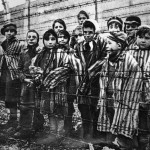
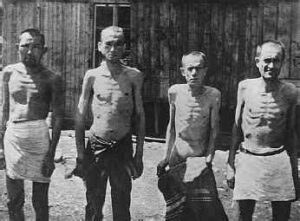 “appointment of Hitler as German chancellor may not be such a threat to world peace as it appears at first blush.” Frederick Birchall, Berlin bureau chief for The New York Times, found “a new moderation” in the political atmosphere following Hitler’s rise to power. Unfortunately, all of them were dead wrong!! Hitler was not a moderate. He was, in fact, more of a threat than they could ever have imagined. Hitler was the epitome of evil, and like it or not, any journalist who softened the story, was guilty of hiding the evidence.
“appointment of Hitler as German chancellor may not be such a threat to world peace as it appears at first blush.” Frederick Birchall, Berlin bureau chief for The New York Times, found “a new moderation” in the political atmosphere following Hitler’s rise to power. Unfortunately, all of them were dead wrong!! Hitler was not a moderate. He was, in fact, more of a threat than they could ever have imagined. Hitler was the epitome of evil, and like it or not, any journalist who softened the story, was guilty of hiding the evidence.
 We have come to expect apartment buildings to look pretty much the same. There might be a few structural differences, but basically the idea is small homes stacked on top of each other, so that multiple families can be housed is a relatively small space. These days I have seen more buildings that look almost like very large houses, mansions even, but the reality is that they buildings house many families, and the apartments are rather cookie-cutter and plain.
We have come to expect apartment buildings to look pretty much the same. There might be a few structural differences, but basically the idea is small homes stacked on top of each other, so that multiple families can be housed is a relatively small space. These days I have seen more buildings that look almost like very large houses, mansions even, but the reality is that they buildings house many families, and the apartments are rather cookie-cutter and plain.
One building…the Waldspirale, which means forest spiral in English, is not just another random residential building. Designed by Friedensreich  Hundertwasser, this architectural wonder located in Darmstadt in Germany. Construction began at the end of 1990s and was completed in 2000. This building is no ordinary structure. The U-shape of the building is characterized by unique multicolored facade and lack of straight lines. The plan was to make sure that no other building looked quite like this one. The inside of the building is just as unique as the outside. The inner wall corners are rounded to match the outer walls of the building. The building has 105 apartments, a garage, and a playground for children…with a tiny artificial lake…much more than the average apartment building in the 90s. The building is really irregularly shaped, and while it seems short, the highest point of the building goes up to the 12th floor. That is all interesting, but what I find the most interesting is that not one of the 1000 windows in the building are the same and the handles on the doors are also different. Imagine just finding 1000 different windows and probably as many different doors too.
Hundertwasser, this architectural wonder located in Darmstadt in Germany. Construction began at the end of 1990s and was completed in 2000. This building is no ordinary structure. The U-shape of the building is characterized by unique multicolored facade and lack of straight lines. The plan was to make sure that no other building looked quite like this one. The inside of the building is just as unique as the outside. The inner wall corners are rounded to match the outer walls of the building. The building has 105 apartments, a garage, and a playground for children…with a tiny artificial lake…much more than the average apartment building in the 90s. The building is really irregularly shaped, and while it seems short, the highest point of the building goes up to the 12th floor. That is all interesting, but what I find the most interesting is that not one of the 1000 windows in the building are the same and the handles on the doors are also different. Imagine just finding 1000 different windows and probably as many different doors too.
 While it was designed by Austrian artist Friedensreich Hundertwasser, it was planned and implemented by architect Heinz M Springmann and constructed by the Bauverein Darmstadt company. I’m sure the uniqueness of the building, while somewhat simple to design, would take a lot of planning and the structure would take some special planning to make it stable enough to carry out the structure as it was designed the uniqueness of the plan. Since I, like many other people have watched the DIY channels, I know that the more unique the structure the more work goes into making it stable. While some people might consider it weird to live in such a building, I think it might be kind of fun.
While it was designed by Austrian artist Friedensreich Hundertwasser, it was planned and implemented by architect Heinz M Springmann and constructed by the Bauverein Darmstadt company. I’m sure the uniqueness of the building, while somewhat simple to design, would take a lot of planning and the structure would take some special planning to make it stable enough to carry out the structure as it was designed the uniqueness of the plan. Since I, like many other people have watched the DIY channels, I know that the more unique the structure the more work goes into making it stable. While some people might consider it weird to live in such a building, I think it might be kind of fun.

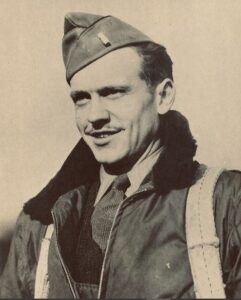 Because my dad, Allen Spencer was the flight engineer and top turret gunner on a B-17G in World War II, the B-17 has always held my interest. The plane was practically indestructible because of its great flying characteristics, resistance to combat damage, and fierce defensive firepower. Built by Boeing, it was called the B-17 Flying Fortress and it was the backbone of the American bomber force in Europe. In the European Theater of World War II (1939-1945), “one of the most dangerous occupations for Allied soldiers, sailors, or airmen was the flying of strategic bombers.” That was a statement that surprised me a little, because I would have expected the men on the ground to be in far more danger. I knew that there was a time my dad had to hang out of the open bomb bay doors to crank the landing gear down when they were damaged in combat, and I vaguely recall that they lost a ball turret gunner when he was wounded in battle and, while they pulled him out to render aid, they couldn’t save him.
Because my dad, Allen Spencer was the flight engineer and top turret gunner on a B-17G in World War II, the B-17 has always held my interest. The plane was practically indestructible because of its great flying characteristics, resistance to combat damage, and fierce defensive firepower. Built by Boeing, it was called the B-17 Flying Fortress and it was the backbone of the American bomber force in Europe. In the European Theater of World War II (1939-1945), “one of the most dangerous occupations for Allied soldiers, sailors, or airmen was the flying of strategic bombers.” That was a statement that surprised me a little, because I would have expected the men on the ground to be in far more danger. I knew that there was a time my dad had to hang out of the open bomb bay doors to crank the landing gear down when they were damaged in combat, and I vaguely recall that they lost a ball turret gunner when he was wounded in battle and, while they pulled him out to render aid, they couldn’t save him.
What I didn’t know about was something that happened on January 1, 1945, that was so bizarre that it seems like a ‘tall tale’ more than an actual event. Nevertheless, it was an actual event, and it was shocking. On that day, the Flying Fortress and the men who flew them were going to be tested beyond any limits they could have imagined, and beyond anything they were trained for. During a chaotic battle complete with ferocious anti-aircraft gunfire (flak) and enemy fighters, two B-17 Bombers managed to collide. A B-17, number 43-338457, piloted by 1st Lieutenant William G MacNab and 2nd Lieutenant Nelson B Vaughn, had risen upward. The top turret guns on MacNab’s plane had pierced through the aluminum skin on the bottom of 1st Lieutenant Glenn H Rojohn’s B-17, number 42-231987, binding the two huge planes together, as Rojohn’s co-pilot 2nd Lieutenant William G Leek, Jr said, like ‘breeding dragonflies.’ The two planes had become one. Upon impact, instead of exploding or breaking into pieces, the colliding planes became stuck together in a piggyback fashion, one atop the other. I’m sure that the men in the top plane, at least were in shock at this strange turn of affairs. I say the top plane, because it is thought that the men in the bottom plane were incapacitated or dead. There was no communication with them. Once the men realized that they weren’t going to crash, they would have to figure out their next move.
Even more shocked than the crew of the B-17 were the German fighter pilots who suddenly saw the whole confusing, but disastrous event. People just don’t expect that a mid-air collision could result in two planes stuck together. For the German fighter pilots, however, the situation took on an even more bizarre tone, because they honestly thought that the US must have created some sort of new secret weapon!! For the men onboard, the situation was dire. I’m sure they expected the explosion to come at any moment, so some of the airmen bailed out. The pilot of the top bomber, Rojohn tried, but was unable to separate the aircraft. Strangely, he was able to control the flight of the ‘hybrid dual-bomber’ somehow, despite turning his own engines off. The lower plane’s engines were still running, because its propellers were still turning. There was no communication with the crew of the bottom plane, which is why it was assumed that they were either incapacitated or already dead.
In a valiant effort, Rojohn decided to try to land the planes, probably hoping that the other crew could be saved, and complicated by the fact that he and his co-pilot, Leek couldn’t get out anyway. At that point, he might as well do his best to save the two or more of them that he could. He coaxed the joined bombers to a relatively safe landing in Germany at Wilhemshaven. Unfortunately, the lower bomber slid out from under the top bomber upon landing and immediately exploded. While the crew of the lower bomber perished in the landing and subsequent explosion, most of the crew of Rojohn’s B-17 survived and was taken prisoner. While being held in the camps, the German interrogators, who were skeptical of the account of the incident given by 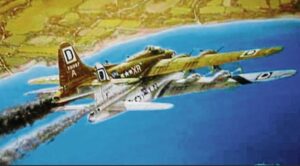
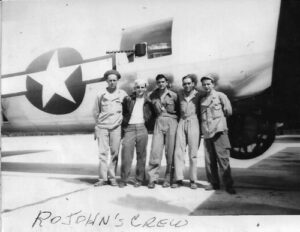 Rojohn, initially were of the opinion the flight represented a new American aerial design. I’m sure they later realized their error, but they must have also realized the resiliency of the B-17 Flying Fortress. Rojohn and his co-pilot, Leek, earned the Distinguished Flying Cross for their feat of aerial skill…a well-deserved award, if you ask me.
Rojohn, initially were of the opinion the flight represented a new American aerial design. I’m sure they later realized their error, but they must have also realized the resiliency of the B-17 Flying Fortress. Rojohn and his co-pilot, Leek, earned the Distinguished Flying Cross for their feat of aerial skill…a well-deserved award, if you ask me.

